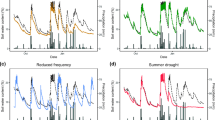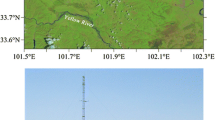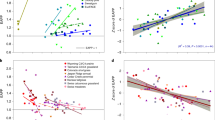Abstract
The complexity of natural ecological systems presents challenges for predicting the impact of global environmental changes on ecosystem structure and function. Grouping of plants into functional types, that is, groups of species sharing traits that govern their mechanisms of response to environmental perturbations, reduce the complexity of species diversity to a few key plant types for better understanding of ecosystem responses. Chambers were used to measure CO2 exchange in grass and moss growing together in a mountain peatland in southern Germany to assess variations in their response to environmental changes and how they influence ecosystem CO2 exchange. Parameter fits and comparison for net ecosystem exchange (NEE) in two ecosystem components were conducted using an empirical hyperbolic light response model. Annual green biomass production was 320 and 210 g dwt m−2, whereas mean maximum NEE was –10.0 and –5.0 μmol m−2 s−1 for grass and moss, respectively. Grass exhibited higher light use efficiency (α) and maximum gross primary production [(β+γ)2000]. Leaf area index explained 93% of light use and 83% of overall production by the grass. Peat temperature at 10-cm depth explained more than 80% of the fluctuations in ecosystem respiration (R eco). Compared to grass, moss NEE was more sensitive to ground water level (GWL) draw-down and hence could be more vulnerable to changes in precipitation that result in GWL decline and may be potentially replaced by grass and other vegetation that are less sensitive.









Similar content being viewed by others
References
Alm J, Schulman L, Walden J, Nykänen H, Mauritanian PJ, Silvola J. 1999. Carbon balance of boreal bog during a year with an exceptionally dry summer. Ecology 80:161–74.
Basiliko N, Moore TR, Jeannotte R, Bubier JL. 2006. Nutrient Input and Carbon and Microbial Dynamics in an ombrotrophic bog. Geomicrobiology Journal 23:531–43.
Bortoluzzi E, Epron D, Siegenthaler A, Gilbert D, Buttler A. 2006. Carbon balance of a European mountain Bog at contrasting stages of regeneration. New Phytol 172: 708–18.
Bubier JL, Moore TR, Crosby G. 2006. Fine-scale vegetation distribution in a cool temperate peatland. Canadian Journal of Botany 84:910–23.
Bubier JL, Crill PM, Moore TR, Savage K, Varner RK. 1998. Seasonal patterns and controls on net ecosystem CO2 exchange in a boreal peatland complex. Global Biogeochemical Cycles 12:703–14.
Bubier JL, Bhatia G, Moore TR, Roulet NT, Lafleur PM. 2003. Spatial and Temporal Variability in Growing-Season Net Ecosystem Carbon Dioxide Exchange at a Large Peatland in Ontario, Canada. Ecosystems 6:353–67.
Busch J, Lösch R. 1999. The gas exchange of Carex species from eutrophic wetlands and its dependence on microclimatic and soil wetness conditions. Phs Chem Earth Part B Hydrology Oceans and Atmosphere 24:117–20.
Canadell J, Jackson RB, Ehleringer JR, Mooney HA, Sala OE, Schulze E-D. 1996. Maximum rooting depth of vegetation types at the global scale. Oecol 108:583–95.
Chapin FS, Jefferies RL, Reynolds JF, Shaver GR Svoboda J, Editors. 1992. Arctic Ecosystems in a changing climate: an ecophysiological perspective. San Diego. Academic Press. 469p.
Clymo and Hayward 1982. The ecology of Sphagnum. In: Smith AJE Ed. Bryophyte Ecology. Chapman and Hall NY. pp 229–90.
Douma JC, Van Vijk MT, Lang SI, Shaver GR. 2007. The contribution of mosses to carbon and water exchange in arctic ecosystems: quantification and relationships with system properties. Plant Cell and Environ 30: 1205–215.
Droesler M. 2005. Trace gas exchange of bog ecosystems, southern Germany. Lehhrstuhl für Vegetationsökologie. Doctoral Thesis, Technical University of Munich. Available online at: http://www.wzw.tum.de/vegoek/publikat/dissdipl.html
Dyck BS, Shay JM. 1999. Biomass and carbon pools of two bogs in the experimental Lakes Area, north western Ontario. Canadian Journal of Botany 77:291–04.
Fenner N, Ostle N, Freeman C, Sleep D, Renolds B. 2004. Peatland efflux partitioning reveals that Sphagnum photosynthate contributes to the DOC pool. Plant and Soil 259:345–54.
Frolking SE, Bubier JL, Moore TR, Ball T, Bellisario LM and others. 1998. Relationship between ecosystem and photosynthetically active radiation for northern peatlands. Global Biogeochemical Cycles 12:115–26.
Gorham E. 1991. Northern Peatlands: Role in the carbon balance and probable response to climate warming. Ecology Applications 1:182–95.
Gordon C, Wynn JM, Woodin SJ. 2001. Impacts of increased nitrogen supply on high arctic heath: the importance of bryophytes and phosphorus availability. New Phytol 149: 461–71.
Hastings SJ, Luchessa SA, Oechel WC, Tenhunen JD. (1989). Standing biomass and production in water drainages of the foothills of the Philip Smith Mountains, Alaska. Holartic Ecology 12:304–11.
Jackson RB, Canadell J, Ehleringer JR, Mooney HA, Sala OE, Schulze E-D. 1996. A global analysis of root distributions of terrestrial biomes. Oecol 108:389–11.
Lafleur PM, Moore TR, Roulet NT, Frolking S. 2005. Ecosystem respiration in a cool temperate bog depends on peat temperature but not water table. Ecosystems 8:619–29.
Leadley PW, Stocklin J. 1996. Effects of elevated CO2 on model calcareous grasslands: community, species, and genotype level responses. Global Change Biol 2:389–97
Li Y-L, Tenhunen J, Mirzae H, Hussain MZ, Siebicke L, Foken T, Otieno D, Schmidt M, Ribeiro NA, Aires L, Pio C, Banza J, Pereira J. 2008a. Assessment and up scaling of CO2 exchange by patches of the herbaceous vegetation mosaic in Portuguese cork oak woodlands. Agric For Meteorol 148:1318–31
Li Y-L, Tenhunen J, Owen K, Schmitt M, Bahn M, Droesler M, Otieno D, Schmidt M, Gruenwald Th, Hussain MZ, Mirzae H, Berhofer Ch. 2008b. Patterns of CO2 gas exchange capacity of grassland ecosystem in the Alps. Agric For Meteorol 148:51–68
Limpens J, Berendse F, Blodau C, Canadell J G, Freeman C, Holden J, Roulet N, Rydin H, Schaepman-Strub G. 2008. Peatlands and the carbon cycle: from local processes to global implications – a Synthesis. Biogeosciences 5:1379–419.
Lindholm T and Vasander H. 1990. Production of eight species of Sphagnum at Suurisuo mire, southern Finland. Annales Botanici Fennici 27:145–57.
Lindroth A, Lund M, Nilson M, Aurela M, and others. 2007. Environmental controls on CO2 exchange in European Mires. Tellus 59B:812–25.
McNeil P, Waddington JM. 2003. Moisture controls on Sphagnum growth and CO2 exchange on a cutover bog. Journal of Applied Ecology 40:354–67.
Moore TR, Bubier JL, Frolking SE, Lafleur PM, Roulet NT. 2002. Plant biomass and production and CO2 exchange in an ombrotrophic bog. Journal of Ecology 90:25–36.
Oechel WC, Vourlitis GL, Hastings SJ, Bocharev SA. 1995. Change in arctic CO2 flux over two decades: effects of climate change at Barrow, Alaska. Ecol Appl 5:846–55
Ostendorf B, Quinn P, Beven K, Tenhunen JD. 1996. Hydrological Controls on Ecosystem Gas Exchange in an Arctic Landscape. Ecological Studies 120:369–86.
Owen K, Tenhunen J, Reischtein M, Wang Q, Falge E, Gayer R, and others. 2007. Comparison of seasonal changes in CO2 exchange capacity of ecosystems distributed along a north-south European transect under non water stressed conditions. Global Change Biology. 13:734–60.
Paul S, Küsel K, Alewell C. 2006. Reduction processes in forest wetlands: Tracking down heterogeneity of source/sink functions with a combination of methods. Soil Biology and Biochemistry 38:1028–039.
Riutta T, Laine J and Tuittila ES. 2007. Sensitivity of CO2 exchange of fen ecosystem components to water level variation. Ecosystems 10:718–33.
Robroek B, Limpens J, Breeuwer A, Schouten M. 2007. Effects of water level and temperature on performance of four Sphagnum mosses. Plant Ecology 190:97–107.
Ruimy MG, Jarvis PG, Baldocchi DG, Saugier B. 1995. CO2 fluxes over canopies and solar radiation: a literature review. Advances in Ecology Research 26:1–68.
Schipperges B, Rydin H. 1998. Response of photosynthesis of Sphagnum species from contrasting microhabitats to tissue water content and repeated desiccation. New Phytol 140:677–84.
Semikhatova OA, Gerasimenko TV, Ivanova TI. 1992. Photosynthesis, respiration and growth of plants in the Soviet Arctic. In: Chapin FS, Jefferies RL, Reynolds JF, Shaver GR, Svoboda J, Eds. Arctic ecosystems in the changing climate. San Diego: Academic Press. p 169–92
Shaver GR, Chapin FS. 1991. Production-biomass relationships and element cycling in contrasting arctic vegetation types. Ecological Monographs 61:1–31.
Shaver GR, Johnson LC, Cades DH, Murray G, Laundre JA, Rastetter EB, Nadelhoffer KJ, Giblin AE. 1998. Biomass and CO2 flux in wet sedge tundras: Responses to nutrients, temperature, and light. Ecological Monographs 68:75–97.
Shaver GR, Street LE, Rastetter EB, Van Wijk MT, Williams M. 2007. Functional convergence in regulation of net CO2 flux in heterogeneous Tundra landscapes in Alaska and Sweden. Journal of Ecology 95:802–17.
Smith LC, MacDonald GM, Velichko AA, Beilman DW, Borisova OK, Frey KE, Kremenetski KV, Sheng Y. 2004. Siberian Peatlands a Net Carbon Sink and Global Methane Source Since the Early Holocene. Science 16303:353–56.
Street LE, Shaver GR, Williams M and Van Wijk MT. 2007. What is the relationship between changes in canopy leaf area and changes in photosynthetic CO2 flux in arctic ecosystems. Journal of Ecology 95:139–50.
Tenhunen J, Lange OL, Hahn S, Siegwolf R, Oberbauer SF. 1992. The ecosystem role of poikilohydric Tundra plants. In: Chapin FS, Jefferies RL, Reynolds JF, Shaver GR, Svoboda J, Eds. Arctic ecosystems in the changing climate. San Diego: Academic Press. pp 213–37
Tuittila ES, Vasander H, Laine J. 2004. Sensitivity of C sequestration in reintroduced Sphagnum to water level variation in a cutaway peatland. Restoration Ecology 12:483–93.
Turunen J, Tomppo E, Tolonen K, Reinikainen A. 2002. Estimating carbon accumulation rates of undrained mires in Finland–application to boreal and subarctic regions. The Holocene12:69–80.
Wohlfahrt G, Anfang Ch, Bahn M, Haslwanter A, Newesely Ch, Schmitt M, Droesler M, Pfadenhauer J, Cernusca A. 2005. Quantifying ecosystem respiration of a meadow using eddy covariance, chambers and modelling. Agric For Meteor 128: 141–62.
Author information
Authors and Affiliations
Corresponding author
Additional information
Author’s Contribution
Werner Borken conceived the study. Ai Nishiwaki, Margerete Wartinger, G. Lischeid and Zaman Hussain conducted measurements. Jan Muhr helped with the methodologies and result discussion. Dennis O. Otieno designed and conducted measurements and wrote the paper.
Rights and permissions
About this article
Cite this article
Otieno, D.O., Wartinger, M., Nishiwaki, A. et al. Responses of CO2 Exchange and Primary Production of the Ecosystem Components to Environmental Changes in a Mountain Peatland. Ecosystems 12, 590–603 (2009). https://doi.org/10.1007/s10021-009-9245-5
Received:
Revised:
Accepted:
Published:
Issue Date:
DOI: https://doi.org/10.1007/s10021-009-9245-5




